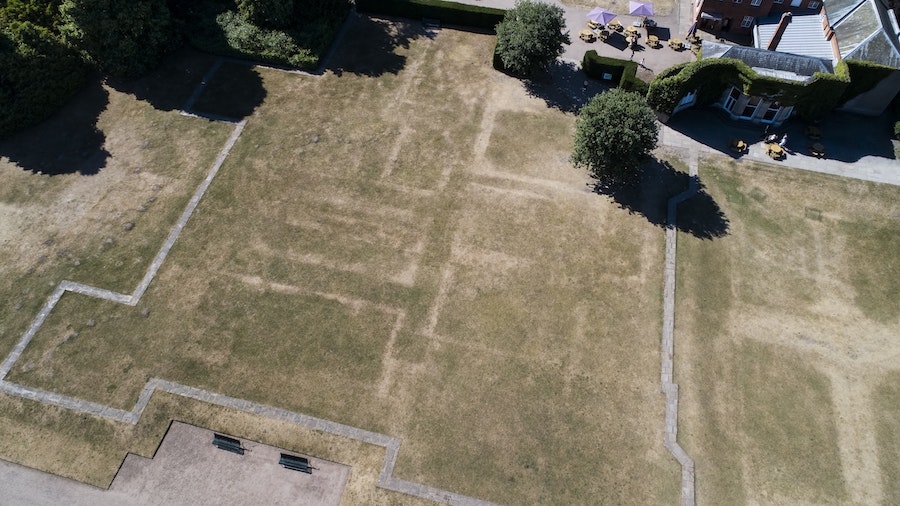Hot summer is great for archaeology as hidden sites show through parched grass
Archaeologists are enjoying this summer’s hot spell because the sun-baked earth is revealing hidden landscapes and building layouts from centuries ago.
The phenomenon known as parch marks makes history easily accessible according to the University of Lincoln’s Professor Carenza Lewis, who has been encouraging people to use drones to photograph the land – or even get to an upstairs window – to catch a glimpse into the past.
I suggest that everyone with access to a #drone (or even an upstairs window) gets photographing lawns, parks and fields to record #archaeology showing as parched marks in the grass. Time is of the essence! @EnglishHeritage @ @AntiquityJ @archaeologyEAA #archaeologyforall
— Prof Carenza Lewis (@CarenzaLewis) July 4, 2018
The marks are visible from the ground too and no fancy equipment is needed.
They show up because buried rocks or stones – potential old roads or foundations – inhibit the growing of crops. The neighbouring section remains green even in the hot temperatures while the yellowing grass gives a tantalising glimpse into what is below – and what might have once stood above ground.
Samantha Stones, a curator for English Heritage spotted “a clear route” from the Roman North Gate to the centre of Silchester, near Basingstoke. English Heritage is working there to conserve the Roman town walls.
A clear route from the Roman North Gate to the centre of #Silchester. @EnglishHeritage #parchmarks #archaeology pic.twitter.com/opQZ5dioXa
— Samantha Stones (@SStones) July 10, 2018
“The parch mark shows the route into/out of the town via the gate,” Stones told Press Association.
In Cambridge, the location of Second World War air raid shelters on Jesus Green was spotted by Sarah Poppy.
WWII air raid shelters on Jesus Green #cambridge showing up nicely #parchmarks pic.twitter.com/BAvLQ18KSN
— CBA East (@CBAEast) July 3, 2018
At the National Trust’s Clumber Park near Worksop, in Nottinghamshire, the rooms of the former mansion house were being mapped as the sun shone.

Clumber Park in Worksop, Nottinghamshire
Ian Barnes, the National Trust’s head of archaeology, explained: “Parch marks are a result of vegetation growing in thin soil over buried archaeological features, such as stone walls, becoming stressed in times of drought as there is less depth of soil to retain moisture. This results in the vegetation being a lighter colour than the more healthy plants on the surrounding deeper soil.
“This differential health of the vegetation when seen from above reflects the pattern of near-surface archaeological features and allows the outlines of long-gone buildings and other features to be mapped.”

Clumber Park in Worksop, Nottinghamshire
The long summer of 1976 saw more than 15 days record a temperature above 32C and is noted by archeologists for helping to surface hidden treasures.
Now there’s a hope that 2018 could be just as fruitful.
“For parch marks to appear circumstances have to be just right, but it is not uncommon,” added Barnes.
“The drought of 1976 is famous in British archaeology for revealing many previously unsuspected archaeological sites. 2018 could be a similarly productive year for new discoveries, buoyed by the advent of drone technology, which allows much easier access to aerial photography.”
Likewise, the Royal Commission on the Ancient and Historical Monuments of Wales described the “unprecedented spell of hot, dry weather” as perfect for archaeological aerial photography.
Its aerial investigator Dr Toby Driver has discovered lost monuments as he’s been documenting known sites over the past week.

The almost ploughed-down medieval castle mound at Castell Llwyn Gwinau, Tregaron, showing clearly under parched conditions (RCAHMW)
He is flying in a light aircraft to permanently record these discoveries for the National Monuments Record of Wales before thunderstorms and rain wash them away.
One image shows either a prehistoric or Roman farm near Langstone, Newport in South Wales.

Newly discovered cropmarks of a prehistoric or Roman farm near Langstone, Newport, south Wales (RCAHMW)
If you needed more of an excuse to get outside this summer, here it is.
The Press Association
Latest posts by The Press Association (see all)
- Maple Cinnamon Granola - January 8, 2025
- 8 things your feet can tell you about your health - January 8, 2025
- 9 ways to look after your emotional health better in 2025 - January 7, 2025
- EastEnders fans to vote on storyline for the first time in 40th anniversary week - January 7, 2025
- Aldi beats rival Lidl as cheapest supermarket of 2024 - January 6, 2025





















